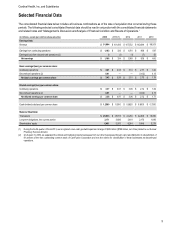Cardinal Health 2014 Annual Report Download - page 21
Download and view the complete annual report
Please find page 21 of the 2014 Cardinal Health annual report below. You can navigate through the pages in the report by either clicking on the pages listed below, or by using the keyword search tool below to find specific information within the annual report.
Cardinal Health, Inc. and Subsidiaries
Quantitative and Qualitative Disclosures About Market Risk
19
We are exposed to cash flow and earnings fluctuations as a
result of certain market risks. These market risks primarily relate
to foreign exchange, interest rate and commodity price-related
changes. We maintain a hedging program to manage volatility
related to these market exposures which employs operational,
economic and derivative financial instruments in order to
mitigate risk. See Notes 1 and 12 of the “Notes to Consolidated
Financial Statements” for further discussion regarding our use
of derivative instruments.
Foreign Exchange Rate Sensitivity
By nature of our global operations, we are exposed to cash flow
and earnings fluctuations resulting from foreign exchange rate
variation. These exposures are transactional and translational
in nature. Principal drivers of this foreign exchange exposure
include the Canadian dollar, Thai baht, Mexican peso, Chinese
renminbi, European euro, Japanese yen, Singapore dollar, and
Malaysian ringgit.
Transactional Exposure
Transactional exposure arises from the purchase and sale of
goods and services in currencies other than our functional
currency or the functional currency of our subsidiaries. As part
of our risk management program, at the end of each fiscal year
we perform a sensitivity analysis on our forecasted transactional
exposure for the upcoming fiscal year. These analyses include
the estimated impact of our hedging program, which mitigates
transactional exposure. At June 30, 2014 and 2013, we had
hedged approximately 48 and 45 percent of transactional
exposures, respectively. The following table summarizes the
analysis as it relates to transactional exposure and the impact
of a hypothetical 10 percent increase or decrease at June 30:
(in millions) 2014 2013
Net estimated transactional exposure $ 378 $ 368
Sensitivity gain/loss $ 38 $ 37
Estimated offsetting impact of hedges (18) (17)
Estimated net gain/loss $ 20 $ 20
Translational Exposure
We have exposure related to the translation of financial
statements of our foreign operations into U.S. dollars, our
functional currency. We perform a similar analysis to that
described above related to this translational exposure. We do
not typically hedge any of our translational exposure and no
hedging impact was included in our analysis at June 30, 2014
and 2013. The following table summarizes translational
exposure and the impact of a hypothetical 10 percent
strengthening or weakening in the U.S. dollar at June 30:
(in millions) 2014 2013
Net estimated translational exposure $ 62 $ 53
Sensitivity gain/loss 65
Interest Rate Sensitivity
We are exposed to changes in interest rates primarily as a result
of our borrowing and investing activities to maintain liquidity and
fund operations. The nature and amount of our long-term and
short-term debt can be expected to fluctuate as a result of
business requirements, market conditions and other factors.
Our policy is to manage exposures to interest rates using a mix
of fixed and floating rate debt as deemed appropriate by
management. We utilize interest rate swap instruments to
mitigate our exposure to interest rate movements.
As part of our risk management program, we perform an annual
sensitivity analysis on our forecasted exposure to interest rates
for the following fiscal year. This analysis assumes a
hypothetical 10 percent change in interest rates. At June 30,
2014 and 2013, the potential increase or decrease in annual
interest expense under this analysis as a result of this
hypothetical change was $4 million and $2 million, respectively.
During fiscal 2014, we purchased marketable securities, which
are classified as available-for-sale and are carried at fair value
in the consolidated balance sheets. The fair value is subject to
change primarily as a result of changes in market interest rates
and investment risk related to the issuers' credit worthiness. At
June 30, 2014, a hypothetical increase or decrease of 100 basis
points in interest rates would cause a potential decrease of up
to $1 million in the estimated fair value.
Commodity Price Sensitivity
We are exposed to market price changes for commodities,
including oil-based resins, cotton, latex, and diesel fuel. We
typically purchase raw materials at market prices and some
finished goods at prices based in part on a commodity price
index. As part of our risk management program, we perform
sensitivity analysis on our forecasted commodity exposure for
the following fiscal year. Our forecasted commodity exposure
at June 30, 2014 decreased from the prior year primarily as a
result of commodity prices and changes in purchasing volumes.
At June 30, 2014 and 2013, we had hedged a portion of these
commodity exposures (see Note 12 of the “Notes to
Consolidated Financial Statements” for further discussion). The
table below summarizes our analysis of these forecasted
commodity exposures and a hypothetical 10 percent fluctuation
in commodity prices at June 30:
(in millions) 2014 2013
Estimated commodity exposure $ 321 $ 369
Sensitivity gain/loss $ 32 $ 37
Estimated offsetting impact of hedges (1) (1)
Estimated net gain/loss $ 31 $ 36
We also are exposed to fluctuations in commodities' prices
through the purchase of finished goods and various other
energy-related commodities, including natural gas and
electricity, through our normal course of business where our
























